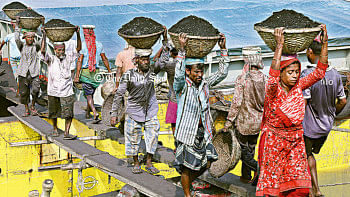IN THE CINEASTE'S EL DORADO

In a tiny corner of Bangladesh Betar building, a handful of government officials have been looking after a collection of the world's rarest treasures. This corner is the third floor of the building which houses the Bangladesh Film Archive (BFA). In this floor, original reels of some of the world's rarest films have been preserved. This invaluable treasurehouse preserves more than 2,500 film reels including the world's first film, memorable films and historical videos of Bangladesh and the subcontinent. Many of these rare collections cannot be found anywhere else on earth. Besides films, its library presents the history of South Asian film industry with thousands of rare books, century old film journals, posters, shooting scripts and what not. It's like a researcher's paradise.
But likewise, the place is not at all accessible to ordinary people. In one of its corridors pile of posters and photographs can be seen scattered on the floor. Most of these vintage film posters and photographs are priceless collectors' items but now rotting in the damp floor. However, Md. Moniruzzaman an assistant director of the archive gives some news of hope. He says, “We have already started to shift our collections and equipment to the new building which will be inaugurated by the end of this year. In the new building we have well equipped and spacious galleries and store rooms to preserve these resources.”
The archive's heart is its eight vaults where thousands of celluloid reels have been preserved. The shelves in the vaults are full of disc-like aluminium cans. The sensitive celluloid films of the movies of lost days have been coiled in the cans at optimum temperature. The celluloid reel of the world's first film directed by Lumiere Brothers released in 1897, has found its shelter in this vault. While showing a reel of the epic Bengali movie Devdas by Promothesh Barua released in 1935 from Calcutta, Mainul a maintenance staff of the vault says, “The Bengali version of the film is so rare that it cannot be found anywhere else, not even in India. In fact the Indian government has requested to procure this several times.”

Besides many rare international films, this archive can boast of a full collection of all the earliest Bengali films released from India and Bangladesh. It has the original reel of Dhrubo, the only film in which our national poet Kazi Nazrul Islam himself acted. The first Bangladeshi film Mukh O Mukhosh released in 1956 has also been preserved here. But the pungent smell of decaying emulsion of the celluloid film is telltale of gross lack of maintenance.
Besides preserving these priceless treasures the archive has also come up with restoration process of the films into digitalised form. Modern equipment has been imported and officials have been trained to convert celluloid films into DVD and blue ray disc. Moniruzzaman says, “We have the technology to convert these films and the process is going on. But the challenge is that our collection is huge compared to the capacity of our equipment. The collection is so huge that with existing technology it might take several centuries to digitalize all the collections.”

A testament of Moniruzzaman's apology can be seen in the corridor adjacent to the vault. Here hundreds of film cans have been stacked up as they could not be accommodated in the vault. Some of these have been marked for checking the film's quality and regular clean up.
Another treasure trove of the archive is its rich library. Tens of thousands of rare film magazines, journals, news clippings, historic documents, posters, still photographs; shooting scripts have been preserved here. A full collection of the Archive's own publications from 1978 to date can also be found here. Turning over the pages of a vintage film magazine like Chitrali or Purbani will take one to the golden age of Bangladeshi films. Besides cine gossip and paparazzi scoops, those magazines also published critical reviews of the then Bangladeshi films; many renowned film directors, critics and researchers used to write regularly for those magazines. Perhaps the lack of such platform can be one of the reasons behind the present bleak reality of Bangladesh's film industry.
This archive's huge collection owes a lot to the contribution of film enthusiasts and film directors. Many of these were collected and donated voluntarily by those film enthusiasts. Film directors like Masihuddin Shaker, Tareque Masud, Catherine Masud, Morshedul Islam, Chashi Nazrul Islam and many others contributed a lot to develop this archive. Dr. Mohammad Jahangir Hossain, the Director General of Bangladesh Film Archive says, “We have only two investigators for collecting films and other materials. They try to convince people to donate their collections to the archive. But most of our collections have been collected and donated voluntarily by film enthusiasts. We also arrange meetings and workshops to get connected with the renowned directors to develop our capacity and collection.”
With a small group of officials Bangladesh Film Archive has been trying to preserve some of the priceless resources of the nation. But unless and until these resources will be made available for the researchers and film enthusiasts, the purpose of this rich collection will not be fulfilled. The authority is expecting that shifting to their new building by the end of this year will solve this problem. We can hope that it will not be delayed further.
The writer can be contacted at shahnawaz.khan@thedailystar.net


 For all latest news, follow The Daily Star's Google News channel.
For all latest news, follow The Daily Star's Google News channel. 



Comments